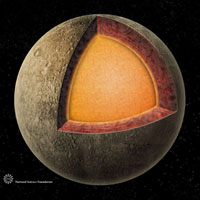This NASA discovery made with the help of radar from Earth solves a 30-year-old mystery

The diagram shows the internal structure of the planet Mercury. The metallic core extends from the center to a large part of the planet's radius. Radar observations showed that the core, or at least its outer part - was melted. Photo by Nicole Rager Fuller, National Science Foundation.
Researchers using ultra-precise planetary radar instruments, including NASA's Golston Observatory in California, have discovered strong evidence that the planet Mercury has a molten core. The findings provide an explanation for a more than thirty-year-old mystery that began with the findings transmitted to Earth by the Mariner 10 spacecraft. The research was published in this week's issue of the journal Science.
Mariner 10, launched in 1973, approached Mercury three times in 1974-5. Among her discoveries, the fact that Mercury has a weak magnetic field, about one percent stronger than Earth's.
"Scientists did not expect to find a magnetic field on the planet Hema," says Prof. Jean-Luc Margot of Cornell University in Ithaca, New York, the lead researcher on the paper. "The magnetic fields of planets are linked to the existence of a molten core, and early theories showed that Mercury is too small to contain a molten core.
According to the theories, Hema contains a silicate mantle surrounding a solid iron core. The iron is considered solid, according to the theory, due to the fact that small planets like Mercury cool quickly after their formation. If Mercury followed this pattern, its core should have frozen long ago. Many believed that it would be possible to solve the riddle only when a spacecraft landed on its hot surface, however in 2002 scientists began pointing some of the most powerful antennas on Earth towards the planet Mercury in an attempt to find the answer. On 18 separate occasions over the past five years, JPL personnel have used the 70-meter-diameter antenna at the Goldstone Radio Observatory and beamed radar signals from it toward the planet Mercury, says Martin Slade, co-author of the paper. According to him, each time the return signal was received from the Hema planet after ten minutes in Goldstone and another antenna in West Virginia.
Measuring the echo from specific land formations on the planet Hema and measuring the time it took to produce the imaging at the two sites - Goldstone and Green Bank in West Virginia, allowed scientists to calculate the rate of rotation of the planet Hema with an accuracy of one thousandth of a percent. The effect was also confirmed by three separate radar observations made of Mercury using the National Science Foundation telescope in Arecibo, Puerto Rico.
Using the data collected, the team of scientists was able to discover small changes in the rotation rate of the planet Hema as it orbited the Sun. These small changes were double those that would be expected from a completely solid body. The findings ruled out that the core is solid, so the only remaining explanation is that the core, or at least its outer part, is molten and does not have to spin at the same rate as the outer shell.
Maintaining a molten core for billions of years requires that it also contain light elements such as sulfur, which will lower the melting temperature of the core. The presence of sulfur supports the idea that the combination of elements, as well as the distance from and approach to the sun are involved in the creation of the process. The chemical composition of the core of a hot star may provide important evidence about the process of creating planets, says Margo. "This is a fundamental element in our understanding of the way in which planets like Earth formed and evolved."
The planet Hema is still hiding its debt. Some of them may be discovered when the Messenger spacecraft, which was launched in 2004 and which is expected to pass by the planet for the first time in 2008, will reach it. The spacecraft will perform several maneuvers and finally begin orbiting the planet Hema in 2011. "We hope that Messenger will provide the answer to the remaining questions that we cannot answer from the ground." Margo said.
For information on the NASA website
